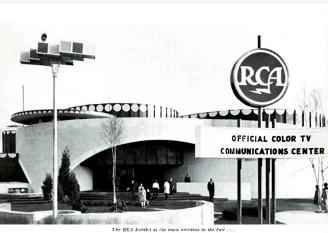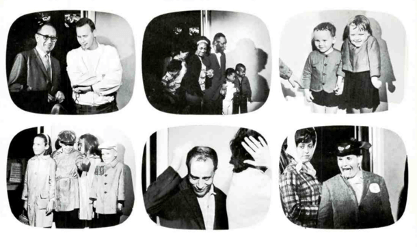Seeing the future was as easy as seeing yourself at the 1964 World’s Fair
Do you remember your first digital selfie?
I don’t. I do remember how difficult it was to take photographs of yourself: the periods of posing in your bathroom, leaning against the sink, trying to find the right angle; the awkwardness of trying to look natural while holding a camera stiffly in your hands. I even remember what it was like to take a picture of yourself with an analog camera, before the digital age, when you’d complete the aforementioned steps and then, send your film off to be developed. Maybe, if you were lucky, a few of your self-portraits would develop and you’d look half-way decent.
Luckily for me and a generation of amateur photographers, Sony invented the self-facing camera phone in 2003. With that invention came the ability to look at yourself and see an accurate, reliable image within seconds.
I pity my poor parents. They had to wait decades for this technology. But even in the dark age before digital, there were glimmers of the future to come at the 1964 – 1965 World’s Fair.

From April 22, 1964 to October 17, 1965, guests could travel to Queens, New York City and visit the Word’s Fair. Walking through 646 acres of exhibits and rides, guests could interact with corporate imaginaries of tomorrow and see themselves in the future. One of the most famous of these was a charming ride at the UNCIF Pavilion, featuring a diorama of children from around the world singing in harmony. Another of these pavilions was the RCA Color TV Communications Center. The sleek white building looked like spaceship: white, oblong, with a series of futuristic loudspeakers on the outside. Inside, as the RCA’s flagship magazine Electronic Age described it:
[It] is an ultramodern color television facility -a “fishbowl” color TV studio in which visitors can see all the activities involved in staging and transmitting color programs. The RCA Exhibit also serves the Fair as the official Color TV Communications Center, sending a continuous flow of entertainment, news, feature, and general information color programs over a closed – circuit network to more than 300 color TV receivers located at exhibits, restaurants, lounges, and waiting rooms throughout the Fair grounds.

From the day of its opening until it closed, the RCA’s Communications Center operated 12 hours a day, daily. It showcased clips from popular films of the year like My Fair Lady and The Sound of Music. The ‘Television in Space’ exhibit displayed photographs from outer space, taken by the RCA-built TIROS weather satellite. The building’s ‘fishbowl’ like structure allowed the public to walk around the perimeter of the central television ‘stage.’ It provided the public a first look at the inner workings of a television studio. RCA staff filmed hours of footage of television, including interviews with athletes and fashion designers. Clowns, singers, and dancers performed acrobatics and musical numbers. Zookeepers brought live otters from the Bronx Zoo.
But, according to The New York Times, one of the most popular parts of the exhibit was the foyer. There, visitors stepped onto a rotating turntable. They first saw themselves on a color camera monitor and then, twenty seconds later, on a second live, tv via a color tape delay system. Incredibly, some of the footage from the ‘See yourself’ feature (as it was called) has been preserved on YouTube.

The film was taken on the final day of the fair, October 17, 1965. The first visitors are two young women, one wearing a kelly green sweater, the other decked out in an elegant white coat. They smile and crack up at the camera. Then three Black teens pose for the camera. A steady stream of visitors parade in front of the electronic eye. Then, suddenly, the film is interrupted by a musical number – perhaps one of the many that the RCA had on its central stage – and a young man and woman harmonize. The film suddenly cuts back to the ‘See yourself’ feature. Quickly, visitors glide silently in front of the camera. One woman attempts to use her view of the camera to place a cigarette in her boyfriend’s mouth. A woman in a mustard lace dress waves at herself in the television viewer. Her boyfriend looks at himself and points. A trio of woman approach. A mother shows her daughter her image; their friend, in a lilac coat, attempts to smooth her hair. The mother rubs her own nose. The first young woman in a kelly green sweater has returned, this time with a cigarette. She blows a smoke ring, looks at herself and, satisfied, looks away. She returns moments later, with more companions and the three of them start goofing off in front of the camera. After they disappear, two additional figures appear, a man and a woman. They start by kissing and seem to enact a television drama for the cameras. They pose, vamp, smile and twirl their hair. For these young people, the novelty of the camera has worn off. They have started to play with the possibilities of it.
Most of the viewers in this clip seemed spell-bound by this exhibit. No doubt, while many of them were familiar with color film at the cinemas, colored television sets themselves were still novelty. Color sets like RCA sold were expensive. In 1965, the average television set cost $525, while a black and white television sold for $150. Similarly, visitors would have been able to see colored photos and films of themselves by the 1960s. (Interestingly, the World’s Fair marked the launch of Eastman Kodak’s popular Super 8mm format). But the idea of being able to instantly see yourself? In living color?
That was truly like seeing the future.
By the time the World’s Fair wrapped up in October of 1965, color television was on the upswing and RCA was feeling good. They estimated that “more than 1.3 million visitors went through the pavilion to see themselves on color television and to watch actual programs being produced in the glass -enclosed color TV studio.” The Electronic Age reported that, by the end of 1964, “Color sales came close to redoubling, with nearly 1.4 million sets sold at the distributor -to- dealer level.” The New York Times declared it the “Year of the Peacock.” I wonder, however, if the RCA Communications Center had helped a generation of younger visitors imagine a world where you might be able to see your own image, instantly, and play around with it? What if RCA, in some small way, had helped influence the ‘selfie’? While RCA itself is no longer actively developing new technologies, I like to think that their engineers helped to create a world where color television became a part of daily life.
Text by Ingrid Ockert
This post is part of our In Living Color exhibit, and made possible in part by the Mercer County Culture and Heritage Commission through funding from the New Jersey Historical Commission and the Mercer County Board of Chosen Freeholders

